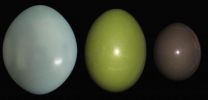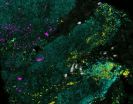How bird eggs get their bling
University of Akron researchers discover mystery behind brilliantly colored eggshell sheen
2014-12-12
(Press-News.org) Splashy blue and green hues pop from under the glassy finish of the Tinamou species' (bird relatives of ostriches, rheas and emus) eggs. Pigments covered by a thin, smooth cuticle reveal the mystery behind these curious shells, University of Akron researchers discovered. The finding could lead to the development of glossy new coatings for
ceramics and floors, potentially enhancing their aesthetic qualities and durability.
After removing the outer layer of the eggshells and examining their chemistry and nanostructure, the researchers discovered the presence of a weak iridescence in the Tinamou's eggshells, creating superficial colors and color changes depending on the angle at which they are viewed and the light cast upon them. The researchers' investigation of how non-pigmentary nanometer-scale structures influence light reflection and produce iridescence that impact eggshell coloration has never before been documented.
"The perceived color changes in relationship with the angles of observation and illumination. This effect can only be produced by nanostructures that influence how light is reflected," says UA post-doctoral researcher Brani Igic. He used experimental manipulations in conjunction with angle-resolved spectrophotometry, scanning electron and atomic-force microscopy, optical calculations and chemical analyses to examine the mechanical construction behind the eggshell gloss and coloration.
Igic and UA research team members Matthew Shawkey, associate professor of biology, and graduate students Daphne Fechyr-Lippens and Ming Xiao, Andrew Chan and Geoffrey I. N. Waterhouse from the University of Auckland in New Zealand, Daniel Hanley and Tomas Grim from Palacký University in the Czech Republic, Patricia R. L. Brennan from the University of Massachusetts, and Mark E. Hauber from Hunter College also found Tinamou eggs' sheen results from an ultra-smooth coating, or cuticle, distinct from typically bumpy eggshells.
"This smoothness causes light to be reflected in a specular manner, like off of a lake or mirror. The bumpiness of other eggs causes them reflect light diffusely, like a cloud," Shawkey explains.
"The research uncovers the longstanding mystery about the cause of these eggs' glossy appearance and shows that birds can make surfaces that rival those of highly polished manmade materials," Shawkey says. "How they do this during egg development and why are great questions for the future."
INFORMATION:
The findings were published by Interface, The Royal Society Publishing, Dec. 10, 2014 http://rsif.royalsocietypublishing.org/content/12/103/20141210.
[Attachments] See images for this press release:

ELSE PRESS RELEASES FROM THIS DATE:
2014-12-12
Extreme climate and weather events such as record high temperatures, intense downpours and severe storm surges are becoming more common in many parts of the world. But because high-quality weather records go back only about 100 years, most scientists have been reluctant to say if global warming affected particular extreme events.
On Wednesday, Dec. 17, at the American Geophysical Union's Fall Meeting in San Francisco, Noah Diffenbaugh, an associate professor of environmental Earth system science at the Stanford School of Earth Sciences, will discuss approaches to this ...
2014-12-12
PHILADELPHIA -- Frequent kidney dialysis is essential for the approximately 350,000 end-stage renal disease (ESRD) patients in the United States. But it can also cause systemic inflammation, leading to complications such as cardiovascular disease and anemia, and patients who rely on the therapy have a five-year survival rate of only 35 percent. Such inflammation can be triggered when the complement cascade, part of the body's innate immune system, is inadvertently activated by modern polymer-based dialysis blood filters. New work by Penn researchers has found an effective ...
2014-12-12
Like a smart sensor that adjusts the lighting in each room and a home's overall temperature, a protein that governs the making of other proteins in the cell also appears capable of controlling fat levels in the body.
The finding, which appeared in Cell Reports on Dec. 11, applies to the Maf1 protein in worms.
A version of the protein, which exists in humans, also regulates protein production in the cell, raising the possibility that it too may control fat storage. A protein with such a function would offer a new target for pharmaceuticals to regulate fat, said Sean ...
2014-12-12
The Perioperative Surgical Home (PSH) model consistently and significantly improves quality of care for patients and reduces health care costs, reports a first-of-its-kind, large-scale literature review of the PSH in the United States and abroad. The review, published online this month in Milbank Quarterly, provides further evidence to support the benefits, and encourage the adoption, of the PSH model.
"There is a global push for more rigorously coordinated and integrated management of surgical patients to enhance patient satisfaction and improve quality of care and ...
2014-12-12
Oil reservoirs are scattered deep inside the Earth like far-flung islands in the ocean, so their inhabitants might be expected to be very different, but a new study led by Dartmouth College and University of Oslo researchers shows these underground microbes are social creatures that have exchanged genes for eons.
The study, which was led by researchers at Dartmouth College and the University of Oslo, appears in the ISME Journal. A PDF is available on request.
The findings shed new light on the "deep biosphere," or the vast subterranean realm whose single-celled residents ...
2014-12-12
BOZEMAN, Mont. - Cathy Cripps doesn't seem to worry about the grizzly bears and black bears that watch her work, but she is concerned about the ghosts and skeletons she encounters.
The ghosts are whitebark pine forests that have been devastated by mountain pine beetles and white pine blister rust, said the Montana State University scientist who studies fungi that grow in extreme environments. The skeletons are dead trees that no longer shade snow or produce pine cones. The round purple pine cones hold the seeds that feed bears, red squirrels and Clark's nutcracker birds. ...
2014-12-12
Amsterdam, NL, December 12, 2014 - A patient who had suffered a traumatic brain injury unexpectedly recovered full consciousness after the administration of midazolam, a mild depressant drug of the GABA A agonists family. This resulted in the first recorded case of an "awakening" from a minimally-conscious state (MCS) using this therapy. Although similar awakenings have been reported using other drugs, this dramatic result was unanticipated. It is reported in Restorative Neurology and Neuroscience.
Traumatic brain injuries occur at high rates all over the world, estimated ...
2014-12-12
New Rochelle, NY, December 11, 2014--In cases of traumatic brain injury (TBI), predicting the likelihood of a cranial lesion and determining the need for head computed tomography (CT) can be aided by measuring markers of bone injury in the blood. The results of a new study comparing the usefulness of two biomarkers released into the blood following a TBI are presented in Journal of Neurotrauma, a peer-reviewed journal from Mary Ann Liebert, Inc., publishers. The article is available free on the Journal of Neurotrauma website at http://online.liebertpub.com/doi/full/10.1089/neu.2013.3245 ...
2014-12-12
Training older people in the use of social media improves cognitive capacity, increases a sense of self-competence and could have a beneficial overall impact on mental health and well-being, according to a landmark study carried out in the UK.
A two-year project funded by the European Union and led by the University of Exeter in partnership with Somerset Care Ltd and Torbay & Southern Devon Health and Care NHS Trust gave a group of vulnerable older adults a specially-designed computer, broadband connection and training in how to use them.
Those who received training ...
2014-12-12
WOODS HOLE, Mass.--Since the first "catalog" of the normal bacterial makeup of the human body was published in 2012, numerous connections between illness and disturbances in the human microbiota have been found. This week, scientists report yet another: Cancerous tumors in the ascending colon (the part nearest to the small intestine) are characterized by biofilms, which are dense clumps of bacterial cells encased in a self-produced matrix.
"This is the first time that biofilms have been shown to be associated with colon cancer, to our knowledge," says co-author Jessica ...
LAST 30 PRESS RELEASES:
[Press-News.org] How bird eggs get their bling
University of Akron researchers discover mystery behind brilliantly colored eggshell sheen



